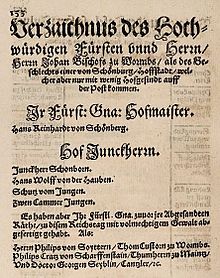Georg Seiblin
Georg Seiblin , also Seyblin or Seublin (born October 9, 1529 , † August 18, 1591 ) was a lawyer and diplomat in the service of the Duchy of Worms .
Live and act
Georg Seiblin studied law and acquired the title of doctor in both rights (ecclesiastical and secular law) at the age of 23 . Presumably he is identical to that Georg Seublin from Vaihingen an der Enz , who enrolled at the University of Tübingen on May 21, 1541 - together with his brother Philipp, who later appears as Procurator at the Imperial Court of Justice - and received his Baccalaureus degree in September 1542 . Soon after his doctorate he was promoted to Chancellor of the Worms Monastery and remained in this position for 35 years. In addition, the Elector of Mainz appointed him his council . Seiblin represented his episcopal lords Dietrich von Bettendorf († 1580) and Georg von Schönenberg († 1595) on many occasions, including a. as envoy to the Reichstag in Augsburg , 1566 as well as 1582 and 1583 during a visit to the Reich Chamber of Commerce in Speyer .
For his services to the bishopric, Bishop Dietrich von Bettendorf awarded him various smaller hereditary fiefs , such as a farm with accessories near the fountain in Neuleiningen , a share in the church property in Wintersheim , Korn and Weingülten in Sausenheim , a monetary benefit in Grünstadt , the Montforter Meadows between Neuleiningen and Altleiningen , as well as an estate with a tenth share in Böhl , after which the family later referred to themselves as Seiblin von Böhl .
Seiblin was married to Anna geb. Fauth and they had several children. Georg Dietrich, doctor of both rights, and Karl, licentiate in both rights, also worked as lawyers. The former later acted as the syndic of the Speyer Cathedral Foundation and assessor (judge) at the Imperial Court of Justice, the latter as the local tax office (public prosecutor). The son Daniel acquired the title of a Magister artium and also went to the Reichskammergericht as an attorney or procurator ; he built a house in Berghausen . According to the sons' university registers, the family originally lived in Ladenburg . The daughter Anna married Philipp Christoph Simonis, Pfennigmeister at the Imperial Court of Justice , son of Philipp Simonis († 1587), notary and secretary of the Speyer Cathedral .
Georg Seiblin died in 1591 and received an epitaph in the cloister of Worms Cathedral, which was destroyed in 1689 . This was lost, but its inscription is handed down in Volume 2 of the “ Thesaurus Palatinus ” by Johann Franz Capellini von Wickenburg († 1752). There it says u. a. that he had provided the Worms Chancellery “for 35 years with the highest level of commitment, integrity, perseverance, agility and wisdom, at the same time he had been of advice to the Archbishop and Elector of Mainz for 11 years and, in these extremely feverish times, from his grief the declining fatherland extraordinarily agitated and tired, finally exhausted from the constant efforts endured for the community and from old age, had died Catholic in the creed that he sincerely cultivated to the last sigh of life. "
literature
- Rüdiger Fuchs: The inscriptions of the city of Worms , Volume 29 of: The German inscriptions , Verlag L. Reichert, Wiesbaden, 1991, ISBN 3882264985 ; (Digital view)
Individual evidence
- ^ Heinrich Hermelink: The matriculations of the University of Tübingen , 1st volume, p. 321, Kohlhammer Verlag, Stuttgart, 1906; (Digital view)
- ↑ Nicolaus Mameranus: The pending Thail des Catalogi of Röm. Kay. May. And then of all the princes and lords of the empire, who were at the Diet in Augspurg, Rhät and Hofgesind , 1566, no page number; (Digital scan)
- ^ Josef Leeb: The Reichstag in Augsburg 1582 , part 2, p. 1443 u. 1529, Oldenbourg Verlag, 2007, ISBN 3486581392 ; (Detail scan)
- ^ Dietrich Kratsch: Justice, Religion, Politics: the Reich Chamber of Commerce and the monastery trials in the late sixteenth century , p. 122, Verlag Mohr Siebeck, 1990, ISBN 3161455649 ; (Digital scan)
- ^ Peter Gärtner: History of the Bavarian-Rhineland Palatinate Castles , Volume 2, p. 125, Speyer, 1854; (Digital scan)
- ^ Regest on ownership of the church property in Wintersheim, 1577
- ^ Michael Frey : Attempt at a geographical-historical-statistical description of the royal Bavarian Rhine district , Volume 2, p. 188, Speyer, 1836; (Digital scan)
- ↑ Johannes Mötsch: Regesten des Archiv der Graf von Sponheim, 1065-1437: 1400-1425 , S. 1681 u. 1682, Verlag der Landesarchivverwaltung Rheinland-Pfalz, 1995, ISBN 392201870X ; (Cutout scan 1) , (Cutout scan 2)
- ↑ Alexander Brunotte, Raimund J. Weber: Publications of the State Archives Administration Baden-Württemberg , Issue 46, Part 3, p. 407, Kohlhammer Verlag, 1999, Issue 16 of: Inventory of the files of the Reich Chamber Court ; (Detail scan)
- ↑ Ashkenaz , Volume 14, p. 335 and 337, Böhlau Verlag, 2004; (Detail scan)
- ^ History of the City of Speyer , Volume 3, p. 225, Kohlhammer Verlag, 1983, ISBN 3170080377 ; (Detail scan)
- ↑ ibid., P. 1698; (Clipping scan 1) ; (Detail scan 2)
- ↑ Epitaph inscription in the “Thesaurus Palatinus” , p. 93 u. 94
| personal data | |
|---|---|
| SURNAME | Seiblin, Georg |
| ALTERNATIVE NAMES | Seyblin, Georg; Seublin, Georg |
| BRIEF DESCRIPTION | Lawyer, Chancellor and diplomat of the Worms Monastery |
| DATE OF BIRTH | October 9, 1529 |
| DATE OF DEATH | August 18, 1591 |

